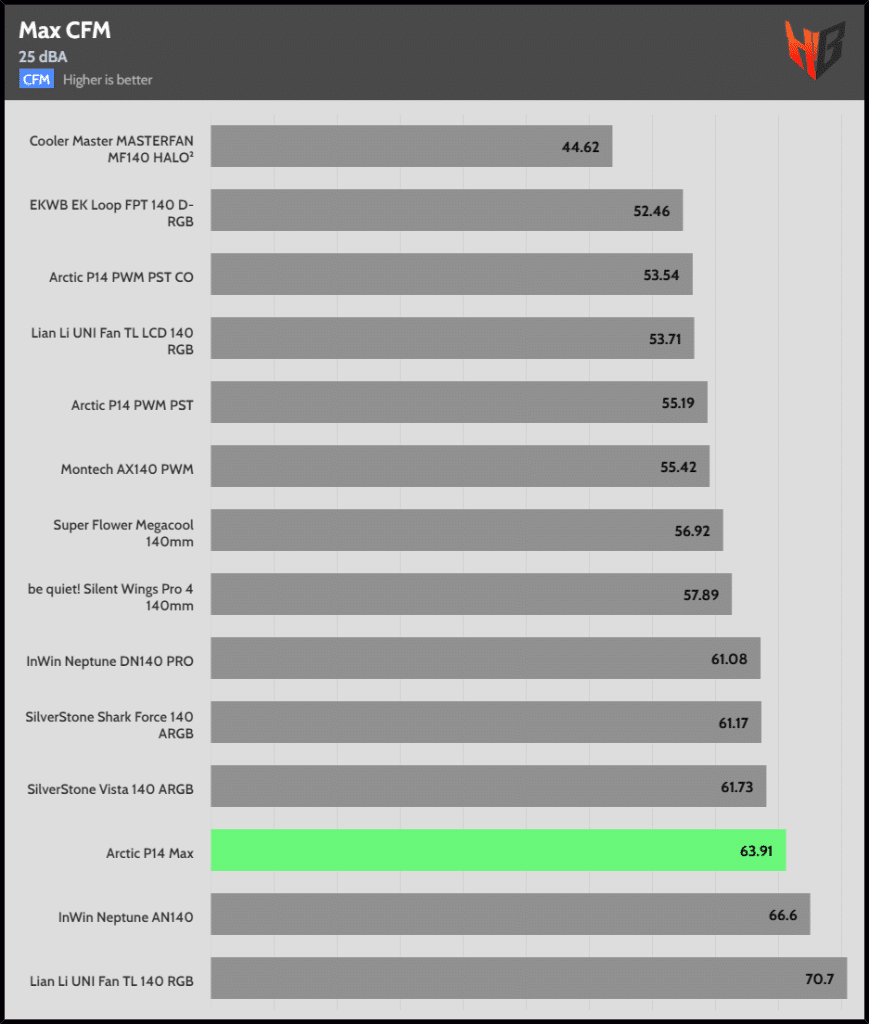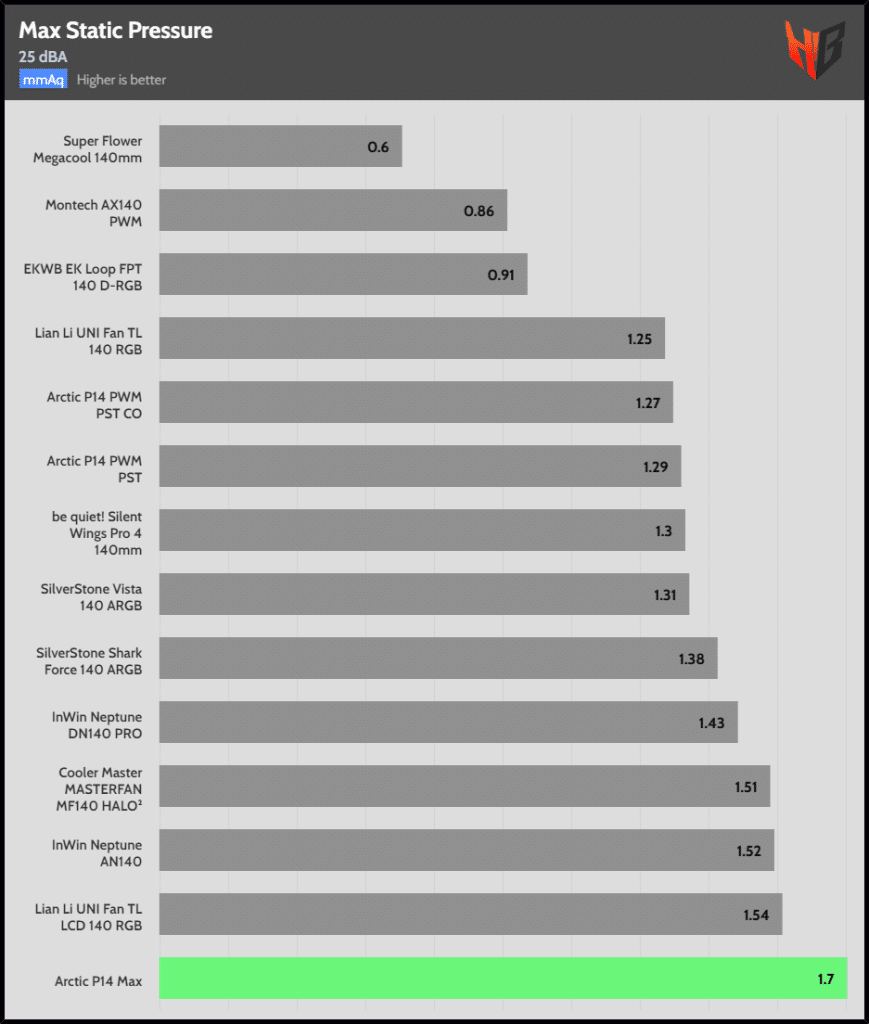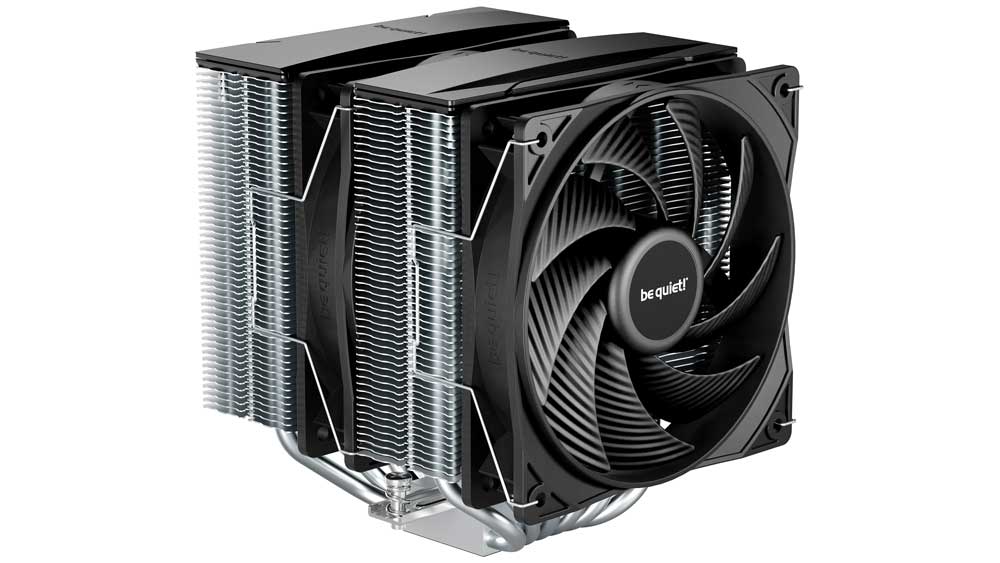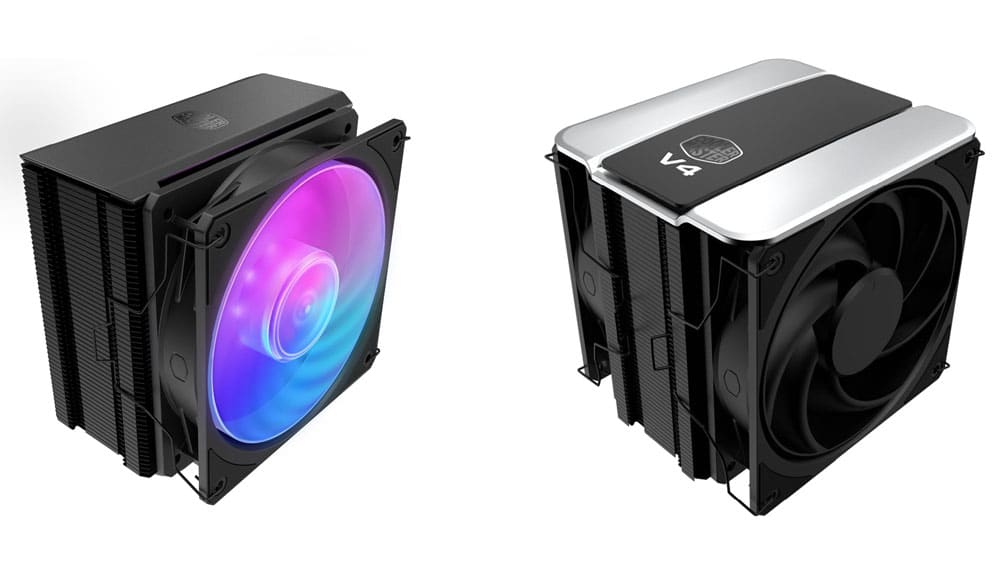Epilogue
The Arctic P14 Max is a fantastic fan, with high build quality and outstanding performance. In pure numbers, it might not be the best-performing 140mm fan. This title belongs to the Super Flower Megacool, which is thicker, so it has room to accommodate a stronger and way more power-hungry motor, but if you look at the normalized noise tests, the P14 Max easily claims the title of the best 140mm fan. You have a killer deal if you combine the top performance with the highly affordable price, especially in the 5-pack package! There is no need to look elsewhere for a 140mm fan from the moment the P14 Max is out. I don’t know how Arctic manages to hit the competition’s pricing scheme so hard, but I do know that there is nothing out there right now matching the P14 Max’s performance per price ratio.
At 25 dBA normalized noise output, low enough not to annoy most users but still providing high speeds to offer decent performance, the P14 Max achieves a very good airflow reading, while its static pressure is pretty far from the rest of the fans. The InWin Neptune AN140 also has a pretty good performance at this noise level despite its budget price. Both Lian Li’s fans perform well in the respective categories, but none of them achieves high performance in both categories, airflow and static pressure. At the same time, their prices are sky-high, especially the price of the UNI FAN TL LCD model.
At $13 for the single fan and $60 for the 5-pack, the P14 Max is a steal! My only complaint is the lack of a daisy chain option. Some users might also want RGB lighting, but I am not one of them. When someone provides me with such a high-performance fan at a bargain price, I say thank you and nothing else!
Before I close this review, I would like to ask Arctic to improve the PWM’s circuit speed reporting function at some point since, again, I couldn’t get steady speed readings from the Corsair Commander Pro that I used, so I had to use a tachometer to obtain speed information. The speed signal might need some filtering, but I didn’t have the time or the mood to hook the fan to an oscilloscope to check it and see what was happening.
If you need a top-performance and highly affordable 120mm fan, look at the following review:
To check all alternative fan offerings, read my Best Cooling Fans article before investing in new cooling solutions. You help me a lot by using my affiliate links, which don’t increase the product’s price. I get a commission from Amazon every time you do it, which can make a difference for me, especially now that I am on my own, working exclusively for my media and not for someone else.
- Highly affordable
- Top performance (airflow and static pressure)
- Top performance per price ratio
- High build quality
- Wide RPM operation (606 – 2859 RPM), including zero RPM mode
- Highly effective noise-reduction design
- Rubber anti-vibration pads
- Rifle bearing for increased lifetime
- Long and flexible power cable
- PWM control
- 6-year warranty
- No daisy chain option
- Increased power consumption at high speeds
- PWM fan speed reporting is not steady
- Rifle bearing and not FDB as advertised
Buy InWin Neptune AN140-3PK
Buy Lian Li UNI Fan TL 140
Buy Lian Li UNI Fan TL LCD 140
Buy ARCTIC P14 PWM CO
Buy SilverStone Technology Vista 140 ARGB
Buy be quiet! Silent Wings 4 140mm
Buy CORSAIR iCUE SP140 RGB Elite 140mm
Buy Noctua NF-P14s redux
Buy NZXT AER P – RF-AP140-FP
Buy ARCTIC P14 PWM PST
Buy Noctua NF-A14 PWM
Buy ARCTIC P14 PWM PST
Buy Lian Li UNI Fan SL140 V2 RGB
Buy Thermaltake Pure 14 ARGB
Buy SilverStone Technology Shark Force 140 ARGB
Buy be quiet! Light Wings 140mm
Buy be quiet! Silent Wings Pro 4
Buy Corsair AF140 Elite
Buy Cooler Master MasterFan MF140 Halo
Buy Lian Li SL Infinity 140mm
Buy Thermaltake Pure 14 ARGB
Buy be quiet! Silent Wings 4 140mm high-Speed







How would these compare to the P14 pros?
Have to check the P14 Pros to find out 🙂
Haha, fair. I will keep an eye out if you manage to test them. Cheers!
Strange that you mention that this one has a rifle bearing – I checked on their site and every fan has the same picture of the bearing. Seems either wrong picture or wrong specs?
correction: it is indeed a FDB & not a Rifle bearing. according to arctic & comparison with other rifle bearings (unless those bearings weren’t rifle bearings)
I wonder which is actually correct. They mention FDB in their spec sheet pdf file, not just on their site.
One would think that seeing as they actually have it written down in their actual sheets.
Furthermore I found this article that states the P14 Max is using FDB bearings – https://www.hwcooling.net/en/new-arctic-p14-max-anti-vibration-and-high-speed/
The early manufactured P12 MAX fans use dual ball bearings. The packaging of Arctic fans is very crude so that many ball bearings were damaged during shipping and make loud noise when using, leading to a lot of returns and complaints. So the factory decided to use FDB bearings, which is cheap, short lifetime but won’t make obvious noise if thrown down. Only few users know how to replace the bearings of a dual ball bearing fan. Users also lack sources of original ball bearings suitable for silent motors. So when the P14 MAX fans come out, they are all using FDB. I understand the manufacturer’s decision to use FDB bearings. But I will only consider buying P14 CO.
How do thes stack up against Noctua?
The best 140 fan now should be the 9RA1412P1G001 from Sanyo Denki (it is 38mm thickness, 25mm is too thin for a 14cm fan). You can get one from Digikey, Mouser or Chip1stop and some other Electronics sales websites(the price in Chip1stop is much more reasonable). The price is high but worth. Hope to see the review of 9RA1412, it is really a good fan for PC building. I think the coming new 14025 fan from Noctua is hard to compete with this product. You should be careful about the transportation when ordering, the ball bearings of this fan are easy to be damaged when shipping and become noisy. It might be a good idea to prepare new 623ZZ(R1030ZZ)ball bearings for silent motors to replace the damaged ones in advance.
Sanyo Denki is a top fan manufacturer.
maybe…but… Rated current [A] = 1.1 > 1.0
…is there some additional SATA connector except for PWM?
…and normalized for noise levels, I don’t think it will be as good as the new NF-A14…despite its advantageous thickness.
1.1A is safe for most motherboard as long as you only connect one fan to one socket. I don’t recommand the DC version since these versions may have additional motor drive noise. It is of course more reliable to supply power through an additional fan controller.
Some users commented that the noise experience of 9RA1412 at 1200 rpm is close to that of the A12X25 at 1000 rpm.
However,9RA1412 is designed for industrial application, which has strict standards and regulations for fan installation. For example, the fan inlet surface should be unobstructed, otherwise it will lead to an additional loud noise. For most cases nowadays with fan mounting bracket for both 12 and 14cm fans,the air inlet surface of the air inlet fan will be close to the bracket and result in additional noise. The problem is not significant for most consuming fans,but for 9RA the problem can not be ignored. When you decede to use 9RA fans for the best thermal and noise performance, you should choose your case carefully, or even design and build one by yourself(lol).